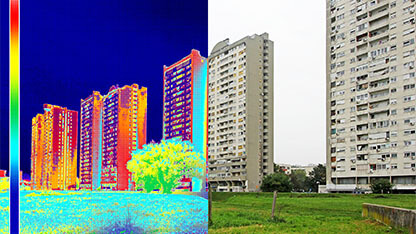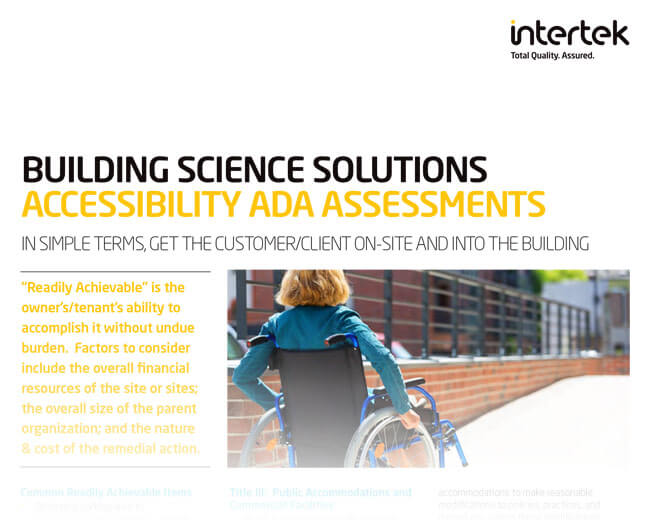Start to finish, our Building Enclosure Commissioning (BECx) expertise helps achieve success in your construction project.
While a certain level of Building Enclosure Commissioning (BECx) may be required by building code in some jurisdictions or necessary for a LEED certification program, it is critical to have the complete BECx services to meet your specific building performance needs. From Pre-Design Phase through the Occupancy and Operations Phase, we can provide the quality assurance and quality control processes customized for the simple building to the increasingly complex campus of multiple buildings. Today’s building designs and details use evolving construction materials and employ challenging installation techniques. Literally anywhere in the world, we can perform the full range of BECx services and activities with our design and construction professionals from across the United States that have the right credentials. Additionally, we can complement the entire BECx process with our unique testing capabilities for subsurface utilities, construction materials, acoustics, structural, whole building airtightness, blast resistance, and energy.
The following are some examples of the BECx services and activities we will customize and provide for your building project to be successful:
Pre-Design Phase
- Work with the Building Owner to develop the Owner's Project Requirements (OPR)
- Develop the Building Enclosure Commissioning Plan with input from the design team
- Evaluate design concepts related to the OPR and the Architect-of-Record's design intent
- Identify the online project management and determine the operable functions related to the BECx processes, including tracking the field issues and resolutions during construction
Design Phase
- Review and comment on the Basis of Design (BOD) prepared by the design team
- Identify and establish the commissioning team and responsibilities
- Develop the building enclosure commissioning specification section to include the BECx activities, commissioned systems, submittal review, mockups, field testing, training verification, and closeout documents
- Review and update the OPR based upon any changes
- Perform and submit the design review of the project drawings and specifications at one or more percentages of document completion and on the final bid documents
- Conduct hygrothermal analysis with computer modeling (WUFI) and thermal simulations (THERM)
- Backcheck responses to the design review, computer modeling, and simulations
- Conduct underground survey of existing utilities and piping
- Perform construction material testing of alternative materials and systems
- Develop construction checklists
- Update the Building Enclosure Commissioning Plan to align with the final bid documents
- Assist in the pre-bid meeting(s) and the construction management team briefing
Preconstruction Phase
- Review the construction schedule for inclusion of BECx activities and processes
- Evaluate the submittals and shop drawings
- Conduct the Building Enclosure Commissioning preconstruction meeting to review the schedule, critical details, and installation and field testing sequencing
- Review Requests for Information (RFIs) and Change Orders (COs)
- Observe mockup construction and field testing, making recommendations for the construction process
- Initiate the field issues and resolutions tracking
Construction Phase
- Finalize the Building Commissioning Plan based on the Preconstruction Phase activities
- Conduct Building Enclosure Commissioning progress meetings
- Continue to evaluate remaining submittals and shop drawings
- Continue to review RFIs and COs
- Perform periodic site visits of the building enclosure system installation using the construction checklists
- Review construction checklists submitted by the contractor
- Conduct pre-test meetings
- Coordinate and witness the field testing
- Maintain the issues and resolution log, following up and closing out items at the end of building enclosure construction
- Review closeout project documents for completeness and for inclusion in the Operations and Maintenance Manual (O & M)
- Prepare and submit the Building Enclosure Service Life Plan, BECx Commissioning Report, and O & M Manual
Occupancy and Operations Phase
- Deliver the O & M Manual and conduct O & M training of facility personnel engaged in building operations
- Perform a 10-month warranty review by interviewing facility personnel on the building enclosure operation and any outstanding performance issues
- Compile and deliver the Final BECx Commissioning Report
Top 10 Questions About Building Enclosure Commissioning (BECx) — Answered
Building enclosures account for up to 70% of construction defect claims. That is why Building Enclosure Commissioning (BECx) is critical to today's building projects. By focusing on quality control and assurance for the roof, exterior walls, windows, below-grade areas, and under-slab systems, BECx helps project teams reduce risk, improve performance, and extend the building's life.
Pam Jergenson, FCSI, CDT, CCS, CCCA, BECxP, CxA+BE, CABS, Technical Director of Building Sciences Solutions at Intertek, answers the top 10 questions most often asked about BECx by building owners, designers, and contractors.
BECx commissioning requirements come in two forms: local energy code and sustainability rating certification goals.
First, you'll want to find the local energy code that applies to your building construction project. The energy code is where commissioning is typically located. Mechanical systems have been commissioned at some level since the 1980s, and utilities have required this type of commissioning since the early 2000s. Today, the energy code is published by the International Code Council (ICC) as the International Energy Conservation Code (IECC. The ICC generally follows the energy standard ASHRAE 90.1, which is written and published by the American Society of Heating, Refrigeration, and Air-Conditioning Engineers (ASHRAE). Building enclosure commissioning requirements in local energy code can be found in the 2021 and 2024 IECC, or through adoption of ASHRAE 90.1-2016 or later.
Second, BECx requirements are also found in sustainability rating certification goals, such as the Leadership in Energy and Environmental Design (LEED) green building certification program. Sustainability rating certification may be chosen by the building owner and designer, or required by the project lender or funding source. That certification may include either Fundamental Building Enclosure Commissioning or Enhanced Building Enclosure Commissioning.
BECx is the process of ensuring quality control and assurance for the entire building enclosure, including the roof, exterior walls, windows and doors (fenestration), below-grade areas, and under-slab components. Simply, the building enclosure is the six-sided shell that separates the interior spaces from the external weather forces. BECx focuses on verifying that the building enclosure meets performance standards, including code-required R-values and U-factors, air leakage testing maximums, and other requirements.
Cx is the process of quality control and assurance for the building systems, specifically heating, cooling, air handling, water, refrigeration, and renewable energy systems. The quality control and assurance of building systems incorporate improved energy usage and reduced operation and maintenance costs. This does not include the building enclosure and is typically performed by a systems engineer familiar with the type of building systems in the project.
An important note about the differences between BECx and Cx processes, other than the systems themselves, is when the bulk of the construction activities occur. BECx activities mainly happen at the beginning of the project construction schedule (after site work), when priority becomes the building shell. Cx activities occur near the end of the project schedule (before interior finishes) and extend through substantial completion. This is when the final testing and balancing occur. However, the Cx consultant may be involved in the submittal review process before the BECx consultant, due to the extensive shop drawings, procurement, and lead times associated with building systems.
Yes, to employ quality control and assurance measures in both the building enclosure and the building systems, a certified consultant in each discipline is necessary, unless the consultant is certified in both disciplines.
In the discipline of building enclosures, there are consultants specializing in specific systems within the building enclosure, such as roof consultants or exterior wall consultants. Those consultants focus on their specialty areas and may not be experienced in how systems combine and function together.
Certified BECx consultants focus on the entire building enclosure, how systems interface, best practices in detailing and transitioning, and, more importantly, the quality control, verification, and performance testing of the constructed systems. Other key pieces in the BECx process include meeting the building owner's requirements and ensuring constructability, sequencing, and compatibility of the systems and materials.
BECx certification is currently available from:
- University of Wisconsin-Madison – BECxP (Building Enclosure Commissioning Process Provider) and/or CxA+BE (Accredited Commissioning Authority + Building Enclosure)
- International Institute of Building Enclosure Consultants (IIBEC) – CBECxP (Certified Building Enclosure Commissioning Provider)
These certification administrators require specific prerequisites, complete a certain number of educational hours, and pass an exam to achieve certification. Additionally, either passing a quiz or earning continuing education hours are needed for certification renewal.”
The Lead Cx can be either or neither. Either the BECx consultant or the Cx consultant can serve as the Lead Cx, depending on which entity has the larger scope in the project or how the commissioning contracts and subcontracts are executed.
Neither the BECx nor the Cx consultant will be the lead if the project requires another entity to fulfill the Lead Cx role, or if the project is large enough to necessitate a third party's assistance in the total building commissioning process. The Lead Cx may have experience in either discipline.
The commonly cited BECx benefit is the alarming fact that building enclosure failures account for as much as 70% of construction defect claims. Preventing the common problem of enclosure failures at turnover is not the only goal of BECx. More importantly, BECx goals are the sustainability and resilience of the building project. Spending time and money on claims or repairs to a new building enclosure is neither sustainable nor resilient, and is rarely included in a new building's maintenance budget.
The return on investment (ROI) for BECx is typically achieved within two to six years of initial construction. For a new building expected to last 20, 50, or more years, BECx pays for itself very early in the building's life. It also reduces the risk of early maintenance budget headaches for the owner.
Mitigating the risk of construction defect claims due to the building enclosure failure is one of the primary benefits of BECx. Additional benefits include well-documented confirmation of the construction process, right-sized mechanical systems for optimum energy savings and reduced resource usage, and tested and verified building performance to meet requirements.
A BECx consultant should be engaged near or at the project inception phase, when the building owner and designer identify project requirements. It needs to be that early because the owner's requirements must include the building enclosure. Starting BECx at the outset provides the greatest impact at the lowest cost. Making enclosure design or construction changes later almost always costs more, or are nearly impossible to implement, rendering BECx less effective and increasing the likelihood of costly missteps or defects.
Generally, the BECx process starts by defining the building enclosure performance requirements and systems to be commissioned early in the project. It continues through the design and construction phases, and finishes with a walkover and final report during the first year of occupancy. Various entities and their requirements may guide the BECx process, including the building owner's standards and expectations, sustainability rating certification goals, energy code compliance, lender or insurer conditions, local jurisdiction covenants and codes, and commissioning guidelines. These requirements may include specific percentages of exterior materials, certain BECx activities, and a 10-month occupancy walkover. Identifying the entities critical to the project and the BECx process is the first step to understanding the extent of BECx involvement.
During the design phase, the BECx process typically involves defining the BECx plan, reviewing design specifications and drawings, providing reports and compliance documentation, and communicating with all parties.
During the construction phase, the BECx process includes overseeing the building enclosure construction, facilitating communications, conducting observations, and maintaining documentation. This also involves resolving building enclosure issues, preparing closeout documentation, issuing the BECx report, and training facility personnel on building enclosure systems.
During the occupancy phase, the BECx process involves interviewing facility personnel about building enclosure performance, walking through all systems for firsthand observations, documenting any issues for follow-up before the end of the first year of occupancy, and submitting a final report.
No. The BECx consultant is only site during specific key construction milestones to witness third-party field testing, or to facilitate BECx site meetings.
The general contractor or subcontractor field supervisor manages daily oversight. As part of the BECx process, construction checklists are used to report daily on key installation aspects, including weather conditions, material and substrate temperatures, area of installation (grid lines), self-performed field testing, and any issues encountered. The BECx consultant may develop the construction checklists or review those produced by the general contractor to ensure proper reporting practices. A construction checklist is created for each building enclosure system, including project-specific requirements from the manufacturer's installation manual and technical sections, as well as determinations made during the preinstallation meeting or mockup review. The combination of these daily field reports and the BECx consultant's site visits is compiled into the final BECx report, which becomes part of the permanent project file.
Yes. Building owners may opt for or require building enclosure field testing by an independent third-party to prevent conflicts of interest within the BECx contract. In some cases, the building owner may allow select field tests to be performed by the BECx firm, with the understanding that the field testing staff does not include the BECx consultant. The BECx consultant's only participation is to witness the test for compliance with standards, verify the results, and review the third-party test report before incorporating it into the final BECx report.
Training facility personnel on the building enclosure is a new requirement for building owners. Training includes a review of the Building Enclosure Systems Manual (also known as the Operations and Maintenance Manual) and a walkover of the building enclosure to demonstrate what to observe during future periodic inspections.
The manual contains specific information on the commissioned building enclosure systems, including:
- Design and construction teams
- Construction documents with addenda
- As-built drawings
- Final shop drawings
- Installing contractor
- Materials installed, location(s), and color(s) (if applicable)
- Warranties (manufacturer's and installers)
- Maintenance manuals
- Recommendations for periodic observations and anticipated maintenance project cycles
Reviewing the manual helps facility personnel handle repairs, manage warranty issues, and plan future projects that tie into existing systems. Knowing the specific systems and materials is a valuable resource for the long-term performance of the building enclosure.
BECx strengthens project outcomes by reducing risk, improving performance, and supporting long-term building resilience. With certified expertise and a structured process, Intertek helps owners, designers, and contractors deliver enclosures that perform as intended, from design through occupancy.
Knowledge Center
Building Health & Wellness: An Overview of Services
Acoustical Testing & Consulting Resources
Remote Pre Inspections for NFPA 80 / 101
Protek - Safety. Everywhere. Every Day
Fire Doors 101: Your Guide to Testing and Certification - Webinar Recording
Tornado Testing & Certification Requirements - Webinar Recording
Plumbing Products Testing & Certification - Webinar Recording
The Evolving Code Evaluation Process White Paper
Proposition 65 & the Furniture Industry Webinar Recording
Why Planning for FCC Certification is Key to Success in the Door Hardware Industry White Paper

Upcoming Tradeshows & Events
Resources
- Search and Buy Building & Construction Standards
- SpecDirect
- Building Products Directory
- Project Connect (formerly myATI) – B&C Products
- Construction Hive – B&C Projects (PSIQest)
- My TestCentral


